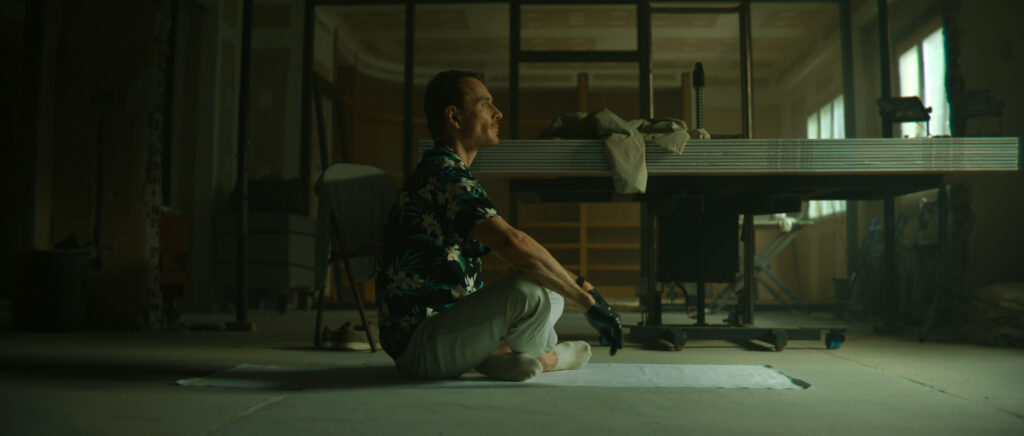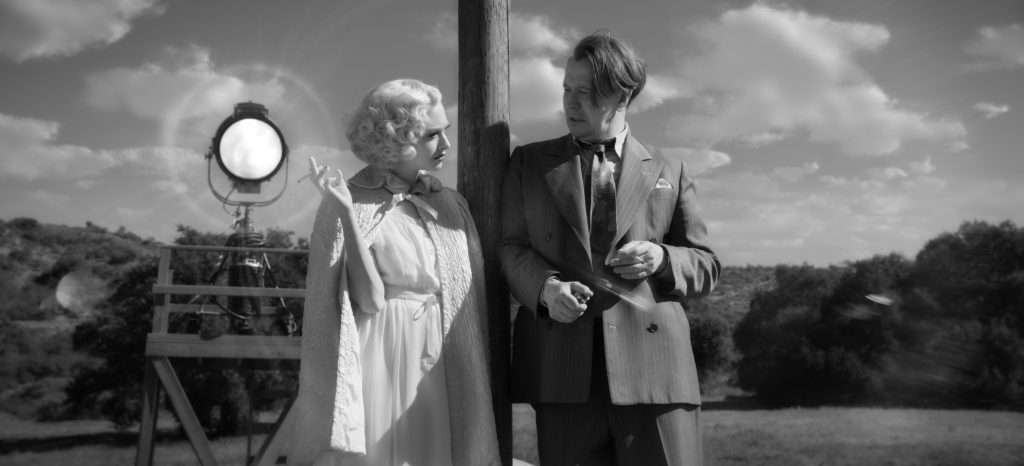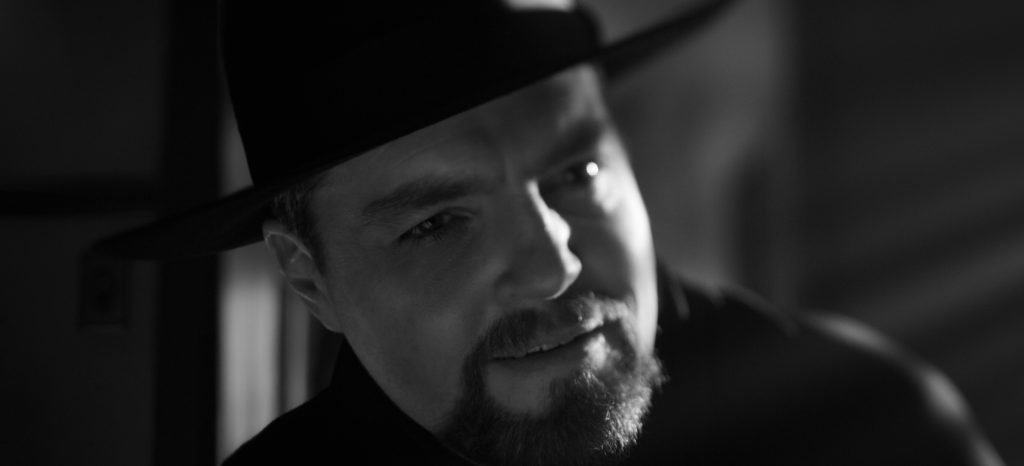October 27, 2023
by Carla Hay

Directed by David Fincher
Culture Representation: Taking place in the United States, Europe, and the Dominican Republic, the dramatic film “The Killer” (based on the French graphic novel of the same name) features a predominantly white cast of characters (with some black people and Latin people) representing the working-class, middle-class and wealthy.
Culture Clash: An assassin goes on a revenge mission to find and kill the people who brutally attacked his live-in girlfriend during a home invasion.
Culture Audience: “The Killer” will appeal primarily to people who are fans of filmmaker David Fincher, star Michael Fassbender, and taut thrillers about assassins.

“The Killer” isn’t the best work from the stars and filmmakers of this somewhat predictable drama about an assassin who goes on a personal vendetta. However, the movie’s performances are above-average. The voiceover narration will get mixed reactions. Some viewers will find this constant narration to be a very annoying distraction, while other viewers won’t mind or will think the narration is one of the best aspects of the movie. “The Killer” had its world premiere at the 2023 Venice International Film Festival and its North American premiere at the 2023 New York Film Festival.
Directed by David Fincher and written by Andrew Kevin Walker, “The Killer” is based on the 2018 French graphic novel of the same name, written by Alexis “Matz” Nolent and illustrated by Luc Jacamon. The movie plays out very much like a graphic novel, with listed chapters and simple dialogue. In the movie, the real name of the title character (played by Michael Fassbender) is never revealed. For the purposes of this review, this assassin will be referred to by the name is he has in the movie’s end credits: The Killer.
The Killer is an American who uses aliases that are the names of famous characters from American TV series. It’s an example of the movie’s wry comedy that the people he encounters don’t notice or don’t even know that the name he has is the same as a TV character. Among the fake names that he uses are Felix Unger and Oscar Madison (“The Odd Couple”), Archibald Bunker (“All in the Family”), Sam Malone (“Cheers”) and Lou Grant (“The Mary Tyler Moore Show,” “Lou Grant”).
Nothing is revealed about The Killer’s personal background before he became a murderer for hire. All that is really known is that The Killer is an elite assassin who is hired by wealthy people. He is considered among the “best of the best” because he’s very meticulous, he has a reputation for never making mistakes, and he has never been caught. But his error-free track record is about to change.
From the movie’s opening scene, viewers get a load of The Killer’s innermost thoughts through voiceover narration. These inner thoughts do not let up for the entire movie. It’s in contrast to the fact that The Killer doesn’t have a lot of scenes where he’s actually talking out loud. He spends a lot of time by himself and talks to people only when necessary.
The movie’s first 10 minutes show The Killer doing what is part of his assassin job: stalking his target and waiting for the right moment to commit the murder. This preparation requires discipline and the ability to tolerate waiting in one place for a long period of time. As The Killer explains in the beginning of the movie: “It’s amazing how physically exhausting it can be to do nothing.” He adds that if you can’t endure boredom, “this work is not for you.”
Well, there’s a lot more to being an assassin than the ability to endure boredom. It takes a certain lack of humanity to kill people for money. The Killer has this to say about his deadly job: “Popeye the Sailor said it best: ‘I am what I am.'” He then says, as if to justify that he’s just a cog in the wheel of sin and corruption: “I’m not exceptional. I’m just a part.” This particular statement carries weight, considering what he says at the very end of the movie.
The Killer says other things to indicate that he’s extremely jaded and emotionally disconnected from a lot of things. For example, he utters, “Luck isn’t real, nor is karma, nor is justice.” But then, he contradicts himself and says that people should consider themselves lucky if they never meet him.
In order to stalk his victims, The Killer has to stay at places close to where he can observe the target and the target’s routines. The Killer quips, “I used to book a lot through Airbnb. Not anymore. Those [Airbnb] Superhosts love their nanny cams.”
In the beginning of “The Killer,” he is shown in Paris at a high-rise hotel that is directly across from a stately home where he can clearly see inside the home. The home is where his target is and where The Killer is setting up his sniper gun to commit the murder. Inside the home, the target is a middle-aged man (played by Endre Hules) enjoying the company of a dominatrix (played by Monique Ganderton), who is just about to start their session.
The Killer takes aim and fires. And he shoots and kills the wrong person: the dominatrix. The middle-aged man reacts with shock. In a nearby room, a few servants hear the gunshot, go into the room, see the dead woman, and panic ensues. As soon as The Killer sees the mistake that he’s made, he quickly leaves the hotel and drives away, as police cars driving in the opposite direction toward the murder scene. Before he leaves the scene, The Killer says in a voiceover, “WWJWBD: What would John Wilkes Booth do?”
Shortly after this botched assassination, The Killer is in a phone conversation with a man named Claybourne (played by Arliss Howard), who hired The Killer for this murder. The client is furious with The Killer, who is shocked and embarrassed about this colossal mistake. It’s the first time The Killer has bungled an assassin job by murdering the wrong person. Claybourne hisses at The Killer that it’s too late to get another chance to kill the target: “The window of opportunity has closed.”
The Killer knows there will be severe consequences to him for this mistake. On a hunch, he rushes back to his home hideout in the Dominican Republic. The place has all the signs that a violent home invasion has recently taken place. Windows are shattered by gun bullets, indicating a forced entry. Items inside the home are smashed, shot up, or in other forms of disarray. There’s blood on the floor and walls. And his live-in girlfriend Magdala (played by Sophie Charlotte) is missing.
The Killer finds out that Magdala is in a local hospital. She’s been brutally attacked and is temporarily in a coma. Magdala’s brother Marcus (played by Emiliano Pernía) is also at the hospital. Marcus says to The Killer about the home invaders: “They came for you.” When Magdala regains consciousness, she tells The Killer that the two people who attacked her (a man and a woman) were not disguised and she can describe them.
Just like her brother Marcus, Magadala also seems to know what The Killer does for money and that the home invasion had something to do with The Killer’s deadly job. “I didn’t tell them anything,” she says to The Killer, as if she wants to assure him that she will stay loyal to him. The Killer knows this assault is revenge for his botched assassination. He feels guilty about it but he mostly feels very angry.
The rest of “The Killer” shows him on a vendetta to find the people who attacked Magdala and murder them. He has to use detective skills to find these attackers because he doesn’t have much information at the beginning of his investigation. His revenge mission takes him to different parts of North America and Europe. (“The Killer” was filmed in Paris, Illinois and the Dominican Republic.)
Some of the memorable people he encounters along the way are an international trade attorney named Edward Hodges (played by Charles Parnell); Edward’s administrative assistant Dolores (played by Kerry O’Malley); and nameless characters described in the movie’s end credits only as The Expert (played by Tilda Swinton) and The Brute (played by Sala Baker). During his revenge scheme, viewers will hear more of The Killer’s inner thoughts.
A life motto that The Killer keeps repeating are these sentences: “Forbid empathy. Empathy is weakness. Weakness is vulnerability.” One of the main concepts of The Killer is that he thought he could separate his personal feelings and his personal life from his job, but the attack on Magdala was a rude awakening on how his job could dangerously spill over into his personal life. And therefore, his perception of empathy as a “weakness” starts to change.
The Killer previously murdered people for money as a business transaction. Now, he’s on a murderous rampage for emotional reasons and pure revenge. The movie doesn’t try to have any moralistic preaching about which type of murder is more “noble” than the other. The movie hinges on Fassbender’s capable and somewhat fascinating performance, where he has to go from cold-blooded and aloof to someone who is so fired up with thoughts of revenge for a loved one, it becomes his obsession.
Even with all the good acting in “The Killer,” after a while, there are formulaic plot developments. It’s the type of movie that can be suspenseful yet have almost no surprises. Because the intentions of The Killer are very transparent, the only mystery is how he is going to find the elusive home invaders.
“The Killer” is very much a “focus on the present day” movie, since almost nothing is told about The Killer’s past or what might happen to him in the future. For example, the movie doesn’t put a lot of thought into what might happen if The Killer murders the home invaders, and people then try to get revenge him for those murders. Fincher’s directing of “The Killer” is efficient but not particularly imaginative. There’s plenty of physical violence in this movie, but the real story of “The Killer” is mostly about violence of the mind.
Netflix released “The Killer” in select U.S. cinemas on October 27, 2023. The movie will premiere on Netflix on November 10, 2023.


